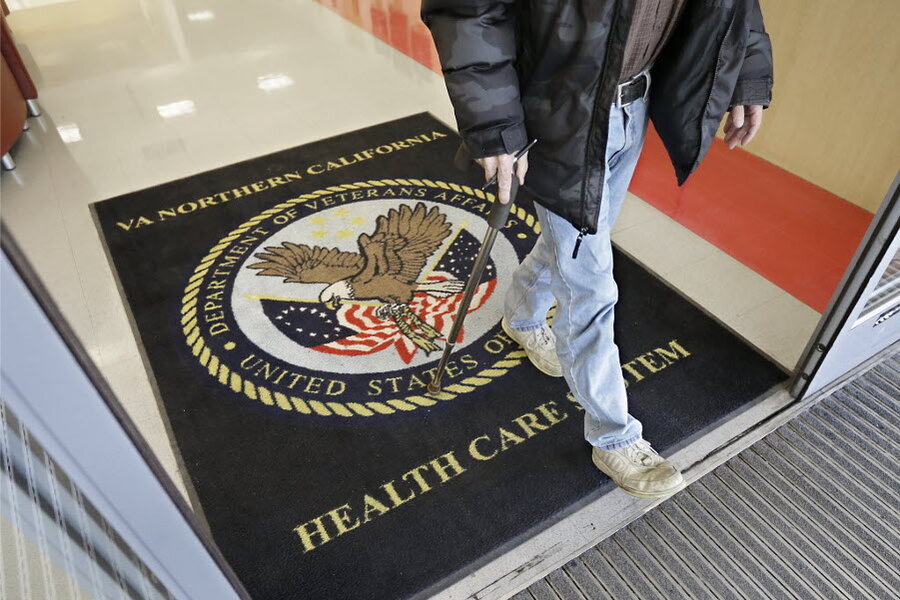VA wait lists longer now than a year ago: 'Something has to give'
Loading...
| WASHINGTON
The number of veterans seeking health care and ending up on waiting lists for a month or more is 50 percent higher now than it was a year ago, when a scandal over false records and long wait times wracked the Department of Veterans Affairs, The New York Times reported.
The VA also faces a budget shortfall of nearly $3 billion, the Times reported in a story posted online ahead of its Sunday editions. The agency is considering furloughs, hiring freezes and other significant moves to reduce the gap, the newspaper reported. The VA budget was increased $16 billion last summer in the wake of the scandal, noted the Christian Science Monitor last August: "Here's what the 'do-nothing' Congress actually did do."
The spending increase funded several efforts to diminish wait times, reported the Monitor's Francine Kiefer:
Q. How does the bill shorten wait times for veterans?
It allows veterans who can’t get an appointment within the VA's wait-time goal, now 30 days, to go outside the VA system for care. That option also exists for those who live more than 40 miles from a VA facility. This $10 billion provision enables a sort of “surge capacity” that “promises to increase veterans’ options for timely, high-quality care,” says Katherine Kidder, research associate at the Center for a New American Security, a think tank.
On the other hand, she warns, “it outsources the VA’s responsibility and removes some of the pressure to reform.”
Q. What about the need to beef up services within the VA?
In the last four years, 2 more million veterans have entered the VA system, with a net increase of 1.5 million more patients, according to Acting VA Secretary Sloan Gibson. The legislation provides $5 billion to pay for more doctors and nurses and deal with space restrictions in crowded facilities. The VA will be allowed to lease at least 27 medical facilities to help provide access that is closer to home for many veterans, and increase the availability of specialty care.
In the last year, the VA has increased capacity by more than 7 million patient visits per year, double what officials originally thought they needed to fix shortcomings, the Times reported. However, the newspaper added, department officials did not anticipate just how much physician workloads and demand from veterans would continue to soar. At some major veterans hospitals, demand was up by one-fifth, the paper reported.
Contributing to the rising demand are new categories of veteran injuries that the VA has agreed to take responsibility for, as the Monitor's Kevin Truong reported Friday:
Forty years after the end of the Vietnam War, the US government has amended regulations to provide disability benefits to more than 2,000 Air Force veterans and reservists who were exposed to Agent Orange while in contact with contaminated aircraft.
The new disability benefits are expected to cost $47.5 million over 10 years, plus additional health care coverage.
The rule change came after new research from the National Academy of Sciences' Institute of Medicine (IOM) suggested that military personnel who were exposed to the C-123 cargo aircraft that dropped the chemical herbicide were subject to adverse health effects.
Citing interviews with department officials and internal department budget documents it had obtained, the Times reported that doctors and nurses have handled 2.7 million more appointments than in any previous year, while authorizing 900,000 additional patients to see outside physicians.
The Times also reported intense internal debate at the VA over a proposal to address a shortage of funds for a new, more effective but more costly hepatitis C treatment by possibly rationing new treatments among veterans. Certain patients who have advanced terminal diseases or suffer from a "persistent vegetative state or advanced dementia" would be excluded under that plan, the paper reported.
Agency officials expect to petition Congress this week to allow them to shift money into programs running short of cash, according to the newspaper. However, lawmakers may object to removing funds from a new program intended to allow certain veterans on waiting lists and in rural areas to choose taxpayer-paid care from private doctors outside the department's health system, the Times reported.
"Something has to give," the department's deputy secretary, Sloan D. Gibson, said in an interview with the newspaper. "We can't leave this as the status quo. We are not meeting the needs of veterans, and veterans are signaling that to us by coming in for additional care, and we can't deliver it as timely as we want to."





